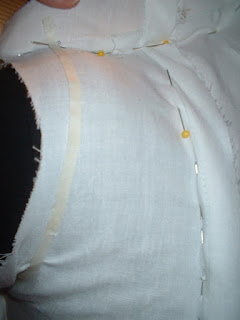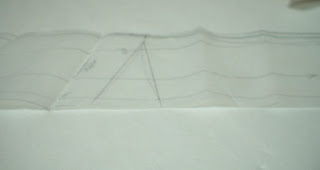Here is a listing of all three parts:
Step One: Prepare for the Fitting
1. Plan to do this on a day when you are feeling good and have a good sewing friend handy. This is not a job you can do alone, nor can I over emphasize its importance. Don't ask your husband to fill in when he has no idea or interest in what you are trying to accomplish. Even working quickly with someone who knows what they are doing, expect it to take 2-4 hours from start to finish.
2.Wear a good well-fitting supportive bra. In fact, buy a new bra just for this occasion. Having made custom wedding gowns for many, many years, this is the one thing that 100% of my clients had in common. You want this mannequin to be the most attractive copy of your figure that you can give it. Besides, a droopy bust is really hard to copy.
3. Wear all of the same undergarments that you normally do. If you usually wear a girdle, or other supportive/ medical needs types of undergarments, do your fitting with those on as well. It's okay to wear a full body leotard as my model did- for modesty.
Step Two: Pin it up Tight as a Drum
1. Put the cover on, with seams outward, pinning closed at the side seams and back at seam lines.
2. Make a determination on how and where to take away the wearing ease to make the cover completely form fitting. If the original pattern was fitted to your figure before attempting this project, the wearing ease for width will be almost evenly distributed throughout. There should be a small amount of ease for height as well. I wish I could say to start with the width and then take out the height, but it's not quite that simple. The main thing to keep in mind is to maintain an even waistline, parallel to the floor, and keep all seams centered and vertical.
3. Pin out the dart space between the breasts, creating a made-for-you cleavage. You may also need to add a dart in the back near the scapula, angling into the arm hole to accommodate the curve of the back.
4. Continually evaluate. Look for ripples and drag lines that need to be stretched and pinned out.
5.. After everything is snug and firm, the last thing to do is mark the armscye and the neckline. I used 1/4" masking tape (available in the quilting section of your fabric store) because I could visually see it better, remove and reposition it if necessary. |
| Pinning out the ease at the princess seam |
 |
| Pinning under the bust for an exact shape |
 |
| cleavage darts at center front |
 |
| Pinning the front |
 | |||
| Pinning the shoulder and marking the armscye |
6. Mark the back seam line on both sides with a pencil or marker and then remove the cover.
Step Three: Mark the Seam Lines
3. Remove the cover from the pattern and remark the pattern seam lines following the perforation. I also reduced my seam allowance to 3/8" along many, but not all seam lines.
If you like, this is the time to mathematically check the dimensions. My darts, which were originally straight, are now changed to a curve to match the body's shape.
4. Press out the original cover fabric, putting like pattern parts together, and re-pin the newly adjusted pattern to it, cutting to the new adjusted size. Sew it together once again, leaving the center back open.
There were only a few adjustments needed.
All those pin lines now need to be marked and transferred to the pattern. Transferring the new markings to your cover pattern are optional, but what if you needed to make a new cover for your mannequin? What are the options?
- Go through this fitting process and re-pad your mannequin again.
- Remove the cover and cut a new one from the original.
- Use the old one no matter the condition.
I recommend it, but if you'd rather do it the quick and dirty way, go ahead and sew up the cover using the pins as your seam line guides and call it done.If you want to transfer your new seam lines to your pattern, and perfect your cover to make sure that both sides will be the same, then read on:
1. With a pencil, mark the pin lines on the cover just as you made them. Don't worry that they might be crooked or angled. I did mine like a dash, marking exactly over the pin.
 |
| Mark the corrected seam line with a colored pencil |
2. To copy the new seam lines to the pattern, take the cover apart by removing the stitches. Now you have two sides, both marked, and neither are exactly the same. You'll have to evaluate both and decide which will be more accurate, or if you need to use a combination of both. Granted, this is not an easy task, nor is one right and the other wrong, but each will have its own consequences. Any education and experience you have will help you, but all the same, this is a decision that you must make.
3. Having the new markings visible, pin the pattern and cover back together. Use a tracing wheel to trace along the new seam lines, perforating the paper below.
3. Having the new markings visible, pin the pattern and cover back together. Use a tracing wheel to trace along the new seam lines, perforating the paper below.
3. Remove the cover from the pattern and remark the pattern seam lines following the perforation. I also reduced my seam allowance to 3/8" along many, but not all seam lines.
 |
| Mark the new seam lines and reduce the cut line |
If you like, this is the time to mathematically check the dimensions. My darts, which were originally straight, are now changed to a curve to match the body's shape.
 |
| Straight darts are now curved |
4. Press out the original cover fabric, putting like pattern parts together, and re-pin the newly adjusted pattern to it, cutting to the new adjusted size. Sew it together once again, leaving the center back open.
Step Four: Time for a Second Fitting
1. I decided it was best to do a second fitting just to be sure that everything was perfect. This fitting went much quicker. Wear the same under clothing as last time.
There were only a few adjustments needed.
My model didn't leave her bra on, so I ignored the bust area and made no changes there.













